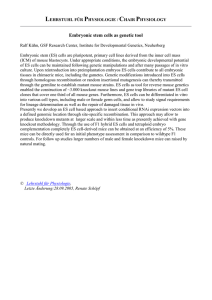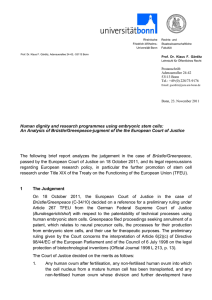article
Werbung
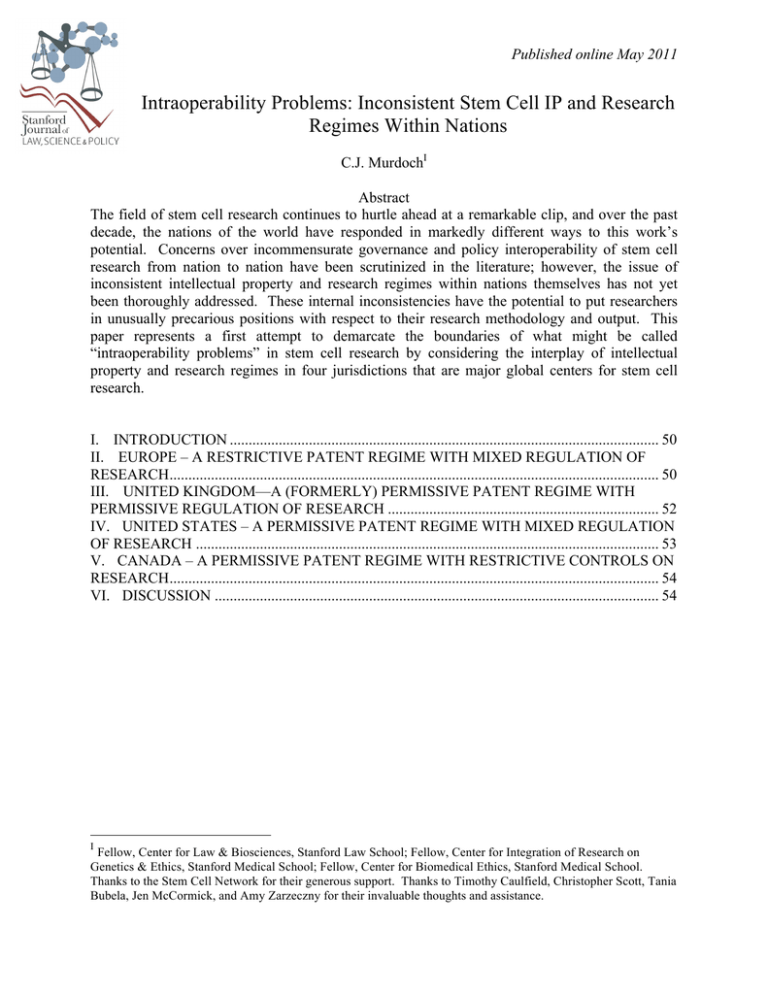
Published online May 2011 Intraoperability Problems: Inconsistent Stem Cell IP and Research Regimes Within Nations C.J. MurdochI Abstract The field of stem cell research continues to hurtle ahead at a remarkable clip, and over the past decade, the nations of the world have responded in markedly different ways to this work’s potential. Concerns over incommensurate governance and policy interoperability of stem cell research from nation to nation have been scrutinized in the literature; however, the issue of inconsistent intellectual property and research regimes within nations themselves has not yet been thoroughly addressed. These internal inconsistencies have the potential to put researchers in unusually precarious positions with respect to their research methodology and output. This paper represents a first attempt to demarcate the boundaries of what might be called “intraoperability problems” in stem cell research by considering the interplay of intellectual property and research regimes in four jurisdictions that are major global centers for stem cell research. I. INTRODUCTION .................................................................................................................. 50 II. EUROPE – A RESTRICTIVE PATENT REGIME WITH MIXED REGULATION OF RESEARCH.................................................................................................................................. 50 III. UNITED KINGDOM—A (FORMERLY) PERMISSIVE PATENT REGIME WITH PERMISSIVE REGULATION OF RESEARCH ........................................................................ 52 IV. UNITED STATES – A PERMISSIVE PATENT REGIME WITH MIXED REGULATION OF RESEARCH ........................................................................................................................... 53 V. CANADA – A PERMISSIVE PATENT REGIME WITH RESTRICTIVE CONTROLS ON RESEARCH.................................................................................................................................. 54 VI. DISCUSSION ...................................................................................................................... 54 I Fellow, Center for Law & Biosciences, Stanford Law School; Fellow, Center for Integration of Research on Genetics & Ethics, Stanford Medical School; Fellow, Center for Biomedical Ethics, Stanford Medical School. Thanks to the Stem Cell Network for their generous support. Thanks to Timothy Caulfield, Christopher Scott, Tania Bubela, Jen McCormick, and Amy Zarzeczny for their invaluable thoughts and assistance. 2010 INCONSISTENT STEM CELL IP & RESEARCH REGIMES WITHIN NATIONS I. 50 INTRODUCTION By all popular accounts, the future of stem cell research gives cause for optimism. Rapid new developments in the science of inducing somatic cells to pluripotency,1 alongside President Obama’s March 2009 reversal of the Bush regime’s limitations on the use of federal funds to support research on embryonic stem cell lines,2 the recent approval of the first batches of lines eligible for said funding,3 and the Geron Corporation’s announcement of FDA approval of the first clinical trial of a stem cell therapeutic4 are all highly encouraging advancements likely to produce heightened hope among an expectant populace. In marked contrast to this public story of linear progress, efforts by policymakers and lawmakers around the world to govern stem cell research are highly variable and often confusing. It is unclear how this heterogeneous oversight may impact research and its outcomes. The diversity of international laws, regulations, and policies surrounding stem cell research has been well explored in the literature.5 When comparing the important research hubs of the world, it soon becomes apparent that there are radically different and even incommensurate national practices surrounding research, intellectual property (IP), and governance. These regimes have arisen and developed out of the diverse cultural, legal, and historical contexts that play a role in policy debates in different countries. Surprisingly, one issue that has not been addressed in any depth in the literature is the degree to which variation and even inconsistency can occur within individual jurisdictions. In particular, the IP and research regimes of a country are often incommensurate. Here, we consider the significance of this matter and its attendant social, legal, and ethical implications by way of four brief, illustrative examples. II. EUROPE—A RESTRICTIVE PATENT REGIME WITH MIXED REGULATION OF RESEARCH The European stem cell patenting regime is a veritable tangle. The European Patent Office (EPO) offers a uniform patent granting and examination process for inventors—the idea presumably being to simplify and harmonize matters for applicants. Once patents are granted by the EPO, however, they become subject to the law of each designated state in which enforcement might be sought.6 Each country has different laws, particularly with respect to one significant issue: moral exclusion. 1 Monya Baker, Stem Cells: Fast and Furious, 458 Nature 962 (2009). Kenneth Taymor & Christopher Thomas Scott, The Practical Consequences of a National Human Embryonic Stem Cell Registry, 5 STEM CELL REV. & REP. 315, 315 (2009). 3 Maggie Fox, U.S. Approves First “Ethical” Human Stem Cell Lines, REUTERS, Dec. 2, 2009, available at http://www.reuters.com/article/2009/12/02/us-stemcells-usa-idUSTRE5B149A20091202. 4 Joe Alper, Geron Gets Green Light for Human Trial of Embryonic Stem Cell-Derived Product, 27 NATURE BIOTECHNOLOGY 213, 213 (2009). 5 See, e.g., Timothy Caulfield et al., Commentary, International Stem Cell Environments: A World of Difference, NATURE REPORTS STEM CELLS (Apr. 16, 2009), http://www.nature.com/stemcells/2009/0904/090416/full/stemcells.2009.61.html; Geoffrey Lomax & Angela McNab, Harmonizing Standards and Coding for Human Embryonic Stem Cell Research, 2 CELL STEM CELL, 201, 201 (2008). 6 Aurora Plomer, Kenneth S. Taymor, & Christopher Thomas Scott, Challenges to Human Embryonic Stem Cell Patents, 2 CELL STEM CELL 13, 15 (2008). 2 51 STANFORD JOURNAL OF LAW, SCIENCE & POLICY Vol. 3 The EPO voluntarily adopted Directive 98/44/EC of the European Parliament in 1999, which is fundamental to the moral exclusion issue. Article 6 of that Directive reads: “[i]nventions shall be considered unpatentable where their commercial exploitation would be contrary to ordre public or morality.” Such inventions include: “(a) processes for cloning human beings; (b) processes for modifying the germ line genetic identity of human beings; (c) uses of human embryos for industrial or commercial purposes; (d) processes for modifying the genetic identity of animals which are likely to cause them suffering without any substantial medical benefit to man or animal, and also animals resulting from such processes.”7 In a November 2008 ruling of the EPO’s highest appeal board, the Enlarged Board of Appeal (EBA),8 the EPO decided to interpret these provisions so as to disallow patents relating to stem cells that can be derived exclusively by the destruction of an embryo. This ruling forbids fundamental patent applications on stem cells and related matters filed by the Wisconsin Alumni Research Foundation (WARF), and has been described as representing a move towards the “constitutionalization” of European patent law, inasmuch as it incorporates higher ranking moral norms which can trump traditional legal eligibility.9 However, it remains unclear whether such a prohibition would extend to downstream derivative products whose original derivation involved destruction of an embryo.10 Furthermore, the EBA was explicit in its decision that this ruling does not exclude the possibility of patents “in general of inventions relating to human stem cells or stem cell cultures,” but only of those that involve methods necessitating the destruction of embryos.11 Even if the EPO granted a stem cell-related patent, however, it is important to note that success under the national laws of individual European nations is not guaranteed. The varied opinion in Europe surrounding biotechnology patents is exemplified by the fact that the 1998 Directive itself was not fully implemented into national law by all E.U. member states until 2007.12 Interpretation of the Directive continues to vary across nations, and accordingly, an EPO patent can yield heterogeneous results across national IP landscapes. All research in Europe must be conducted in accordance with the fundamental ethical principles and human rights laws of the European Union, which mandate the protection of human life, preclude inappropriate state intervention, and require urgency, social desirability, and the primacy of personal well being and the rights of the individual over the sole interests of science and society. Human embryonic stem cell (hESC) research can only be conducted if deemed necessary, if there are no valid alternatives, and if the work is nonredundant.13 These thresholds are fairly low, and accordingly, regulation of research in Europe is more straightforwardly fragmented, with each nation setting its own controls on the practice. These regimes truly run the gamut of regulation: individual nations within Europe have been described 7 Council Directive 98/44/EC, art. 6, 1998 O.J. (L213/13), 18. Eur. Pat. Off., Decision of the Enlarged Board of Appeal of 25 November 2008, 2009 O.J. EPO 306, 306; see generally Mats G. Hansson et al., Commentary, Isolated Stem Cells—Patentable as Cultural Artifacts?, 25 STEM CELLS 1507, 1507 (2007). 9 Pierre Treichel, Patenting of Human Embryonic Stem Cells in Europe, 4 BIOTECHNOLOGY J. 462, 464 (2009). 10 Nayanah Siva, Stem Cells Caught in Morality Clause, 27 NATURE BIOTECHNOLOGY 109 (2009). 11 Eur. Pat. Off., supra note 8, at 331. 12 Robert Fitt, New Guidance on the Patentability of Embryonic Stem Cell Patents in Europe, 27 NATURE BIOTECHNOLOGY 338, 338 (2009). 13 Anja Elstner et al., The Changing Landscape of European and International Regulation on Embryonic Stem Cell Research, 2 STEM CELL RES. 101, 102 (2009). 8 2010 INCONSISTENT STEM CELL IP & RESEARCH REGIMES WITHIN NATIONS 52 both as “restrictive” and “liberal.”14 In some countries, such as Italy and Austria, an effectual ban on all embryonic research is in place.15 On the other hand, in nations such as Belgium and Sweden, not only is research permitted, but the creation of embryos for research purposes, for the derivation of stem cell lines, and for research cloning is also permitted.16 The complex circumstances surrounding this research do have an upside: the EPO cannot patent research in those countries where its conduct is illegal. Conversely, there are some research regimes so stringent as to preclude work that may in fact be patentable by the EPO, as the EPO seemed to hint in its November 2008 ruling. III. UNITED KINGDOM—A (FORMERLY) PERMISSIVE PATENT REGIME WITH PERMISSIVE REGULATION OF RESEARCH The U.K. Intellectual Property Office (UKIPO) updated its policy in February 2009 to harmonize with the European Patent Office EBA’s WARF decision: no stem cells or procedures that come about exclusively by the destruction of embryos or that are derived therefrom may be patented.17 Unlike the EPO, however, the UKIPO decided to interpret Article 6 of Directive 98/44/EC of the European Parliament and of the Council of July 6, 1998 narrowly, making a further critical distinction between totipotency and pluripotency: if a patent relates to human embryonic totipotent cells, it is not patentable because it has the potential to develop into a whole human body. On the other hand, if a patent relates to human embryonic pluripotent cells, it is patentable because it does not hold such potential.18 This hermeneutic, even coupled with EPO harmonization, explicitly allows for a number of hESC patents in the United Kingdom. The U.K. research regime is also quite permissive.19 The Human Fertilization and Embryology Act of 1990 set the ground rules: research on embryos is allowed, but only with a license that is granted under specific conditions. Research licenses are granted by the relevant authority, the Human Fertilisation and Embryology Authority (HFEA), if the research can be demonstrated to serve one of the acceptable purposes in the Act, and even then only on a projectspecific basis, taking into account the competence of the clinical and/or research team.20 Furthermore, all research must have local independent ethics committee approval and the consent of the embryo donors, who must have received counseling. However, if a researcher is successful in getting a license, the types of permissible research are much broader than in most other countries.21 For instance, creation of embryos by in vitro fertilization (IVF) and derivation 14 Rose Isasi & Bartha Knoppers, Mind the Gap: Policy Approaches to Embryonic Stem Cell and Cloning Research in 50 Countries, 13 EUR. J. HEALTH L. 9, 13-15 (2006). 15 Id. at 20. 16 Id. at 22-23. 17 U.K. Intell. Prop. Off., Practice Notice: Inventions Involving Human Embryonic Stem Cells (Feb. 3, 2009), available at http://www.ipo.gov.uk/pro-types/pro-patent/p-law/p-pn/p-pn-stemcells-20090203.htm. 18 Id. 19 Isasi & Knoppers, supra note 13, at 23. 20 See U.K. DEP’T OF HEALTH, HUMAN FERTILISATION AND EMBRYOLOGY ACT 1990—AS AMENDED: AN ILLUSTRATIVE TEXT (2007), available at http://www.dh.gov.uk/prod_consum_dh/groups/dh_digitalassets/@dh/@en/documents/digitalasset/dh_080206.pdf. [CLW: no page number!] 21 Robin Lovell-Badge, The Regulation of Human Embryo and Stem-Cell Research in the United Kingdom, 9 NATURE REV. MOLECULAR CELL BIOLOGY 998, 998 (2008). 53 STANFORD JOURNAL OF LAW, SCIENCE & POLICY Vol. 3 by somatic cell nuclear transfer (SCNT) are also allowed.22 And indeed, the most recent amendment to this legislation, the Human Fertilisation and Embryology Act of 2008, actually broadened the scope of acceptable practices for stem cell researchers, allowing for hybrid embryos and genetic manipulation.23 The United Kingdom used to be one of the few places in the world with consistent IP and research regimes. Since UKIPO’s harmonization with the EPO, however, it has become possible to conduct research in the United Kingdom that is unpatentable (i.e., involves in some respect the necessary destruction of an embryo). IV. UNITED STATES—A PERMISSIVE PATENT REGIME WITH MIXED REGULATION OF RESEARCH In stark contrast to the EPO, the U.S. Patent and Trademark Office (USPTO) has recently upheld three foundational WARF stem cell patents (Thomson, J.A. U.S. Patent Nos. 5,843,780 (1998), 6,200,806 (2001), and 7,029,913 (2006)) after reexamination was granted by request of the Public Patent Foundation and the Foundation for Taxpayer and Consumer Rights in 2006. At stake in the reexamination were technical patent issues of obviousness—not questions of morality, or the patentability of stem cells or their related technologies.24 Indeed, in issuing patents and conducting reexaminations, the USPTO has consistently accepted the prima facie patentability of stem cells and related technologies, instead focusing on narrow issues of patent law as it would for any other patent.25 By contrast, the research regime in the United States is a mixed landscape. States differ markedly on important issues that arise in the regulation of research, such as the procurement of embryos, gametes, and other cells from human donors, and the use and derivation of hESC lines.26 Many states have no hESC research regulation in place. Roughly a dozen states explicitly endorse hESC research, while some clearly preclude derivation. There are continuing efforts to coordinate regulation between states, such as the work done by the Interstate Alliance on Stem Cell Research (IASCR);27 however, significant disparities remain. In Maryland, unused oocytes cannot be donated for funded research.28 If a researcher were to develop a technology that involved the use of an unused oocyte, it would be patentable in the United States, but the research would have to be conducted elsewhere. However, because the IP regime in the United States is permissive, the converse problem does not arise. 22 Timothy Caulfield et al., The Stem Cell Research Environment: A Patchwork of Patchworks, 5 STEM CELL REV. & REP. 82, 84 (2009). 23 Human Fertilisation and Embryology Act, 2008, c. 22, § 4 sch. 2 (Eng.). 24 Yvonne Shyntum & Edward Kalkreuter, Stem Cell Patents—Reexamination/Litigation—The Last 5 Years, 15 TISSUE ENG. PART B REV. 87, 88 (2009). 25 Katja Triller Vrtovec & Christopher Thomas Scott, Patenting Pluripotence: The Next Battle for Stem Cell Intellectual Property, 26 NAT. BIOTECHNOL. 393, 393-94 (2008). 26 Caulfield, supra note 5; Susan Stayn, A Guide to State Laws on Human Embryonic Stem Cell Research and a Call for Interstate Dialogue, 5 MED. RES. LAW & POL’Y REP. 718, 718 (2006). 27 Richard O. Hynes, Stem Cells: U.S . Policies on Human Embryonic Stem Cells, 9 NATURE REVIEWS MOLECULAR CELL BIOLOGY 993, 997 (2008). 28 MD. CODE ANN., ECON. DEV. § 10-438 (West 2011) (“Any unused material donated for State-funded stem cell research may not be an oocyte.”). 2010 INCONSISTENT STEM CELL IP & RESEARCH REGIMES WITHIN NATIONS V. 54 CANADA—A PERMISSIVE PATENT REGIME WITH RESTRICTIVE CONTROLS ON RESEARCH The Tri-Council Statement: Ethical Conduct for Research Involving Humans (TCPS), the Assisted Human Reproduction Act of 2004 (AHRA), and the Canadian Institutes of Health Research (CIHR) Updated Guidelines for Human Pluripotent Stem Cell Research govern stem cell research in Canada. The TCPS prohibits the creation of embryos for research. It allows that lines may be derived from supernumery IVF embryos; however, this is indeed the only presently acceptable means of derivation. A conservative ethos permeated Canadian parliamentary debates leading up to the enactment of AHRA, and most debates centered on the moral status of the embryo and cloning.29 Not surprisingly, then, AHRA bans SCNT and cloning in order to create embryos for research.30 It is unclear whether it would ban interspecies SCNT (iSCNT) embryo creation.31 Parthenogenetic embryos are likely to be considered clones and in violation of AHRA. The differentiation of IPS cells into germ cells is also prohibited because this act involves heritable genetic alteration. Researchers who violate the act to produce embryos for stem cell research could face criminal charges and five to ten years in prison. The CIHR guidelines provide a finergrained regulation of the use of pluripotent cells used in those ways that are otherwise acceptable under TCPS and AHRA. A patent on hESC has not yet been granted in Canada.32 However, the Canadian Intellectual Property Office recently revised its Manual of Patent Office Practice (MOPOP), explicitly addressing the patentability of stem cell-related inventions to include a distinction similar to that of the UKIPO. Totipotent stem cells, because they possess the “inherent ability to develop into animals,” are not patentable. On the other hand, embryonic, multipotent, and pluripotent stem cells, which “do not have the inherent ability to develop into an animal,” are patentable.33 Meaning, with the exception of totipotent cells, many stem cell-related inventions should be patentable in Canada, as scholars and practitioners have long predicted.34 This circumstance creates a remarkable conundrum for researchers, who could face criminal charges, fines, and even jail time if they derive embryos for research, even though they would presumably be eligible for IP protection of any related inventions. VI. DISCUSSION It should be quite apparent that, in several major centers of stem cell research, in addition to or instead of an interoperability problem, there appears to be an intraoperability problem. 29 Timothy Caulfield, & Tania Bubela, Why Criminal Ban? Analyzing the Arguments Against Somatic Cell Nuclear Transfer in the Canadian Parliamentary Debate, 7 AM. J. BIOETHICS 51, 51 (2007). 30 Assisted Human Reproduction Act, S.C. 2004, c. 2 § 5. (Can.). 31 Peter J. Rugg-Gunn et al., The Challenge of Regulating Rapidly Changing Science: Stem Cell Legislation in Canada, 4 CELL STEM CELL 285, 286 (2009). 32 See generally LORI P. KNOWLES, STEM CELL NETWORK, STEM CELL PATENTS (2009), available at http://www.stemcellnetwork.ca/uploads/File/whitepapers/Stem-Cell-Patents.pdf. 33 CAN. INTELL. PROP. OFF., MANUAL OF PATENT OFFICE PRACTICE 17-2 (2009). 34 Timothy Caulfield, Stem Cell Patents and Social Controversy: A Speculative View from Canada, 7 MED. L. INT’L 219, 219 (2006); Memorandum from Anita Nador & Tina Loucaides on Stem Cells: Patents and Related Legal Issues to Bereskins & Parr, LLP (Feb 10, 2003), available at http://www.bereskinparr.com/FRE/News/IntellectualPropertyArticles/pdf/Bio-StemCell-Nador.pdf. 55 STANFORD JOURNAL OF LAW, SCIENCE & POLICY Vol. 3 Inconsistent regimes within legal jurisdictions have the potential to put researchers in unusually precarious positions with respect to their research methodology and output. It has been said that hESCs, because of their great commercial and therapeutic potential, represent a classic example of the type of knowledge that should be accessible to both academia and industry.35 Commentators have often suggested that some patent holders can potentially thwart that expectation of accessibility, as arguably occurred during the well-publicized WARF controversy.36 However, it is worth considering whether inconsistent public laws and policies like those described here could inadvertently produce a similar effect. Is it possible that these incommensurate regimes could affect research outputs, whether directly or indirectly? Might they even affect the number of stem cell-related patent filings? It may already be possible to tell. Research indicates stem cell patent filings may have already peaked.37 Although it will be difficult to control for the great number of confounding variables involved, patent filing data should be scrutinized to determine if any correlation with intraoperability problems obtains. Venture capital investments within a nation are likely to be adversely affected by the uncertainty of incommensurate regulatory environments, and this may be a hypothesis that can also be empirically investigated. The suggestion that IP and research regimes should converge or at least be consistent is not novel; in fact, the UKIPO made direct reference to this idea in making its original decision to draw an interpretive distinction between totipotency and pluripotency: “Implicit in [the office’s] reasoning is the arguably justified assumption that moral exemptions to patents should not conflict with a morally permissive regulatory regime on research.”38 Similar sentiments have been expressed in the ongoing battles surrounding stem cell patents in Germany.39 While it is possible to argue that the variety of international regimes can potentially produce a rich diversity of regional research pursuits, variance within a jurisdiction seems much more likely to produce confusion and inefficiency. There is presently a worldwide economic crisis, which makes efficient practice and translation of science even more important. It may be desirable to bring some internal consistency to the research and IP regimes of the countries discussed. But, regardless of whether or not such consistency develops, it is important that scholars keep a watchful eye on the outputs of the many varied regimes. After all, the current patchwork of inter- and intraoperability problems may also be an exceptional opportunity for concrete learning about the effect of law and policy on research output. 35 Fiona Murray, The Stem-Cell Market—Patents and The Pursuit of Scientific Progress, 356 NEW ENG. J. MED. 2341, 2342 (2007). 36 Alisa Opar, U.S. Tosses Out Patents on Three Wisconsin Stem Cell Lines, 13 NAT. MED. 519 (2007); Erika Check, Patenting the Obvious?, 447 NATURE 16, 16 (2007); Constance Holden, Stem Cells. Prominent Researchers Join the Attack on Stem Cell Patents, 317 SCIENCE 187 (2007). 37 Karl Bergman & Gregory D. Graff, The Global Stem Cell Patent Landscape: Implications for Efficient Technology Transfer and Commercial Development, 25 NATURE BIOTECHNOLOGY 419, 421 (2007). 38 Plomer, Taymor, & Scott, supra note 6, at 16. 39 Alison Abbott, Fresh Hope for German Stem-Cell Patent Case, NATURE NEWS, Nov. 16, 2009, http://www.nature.com/news/2009/091116/full/462265a.html.
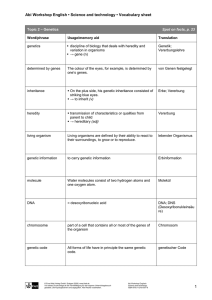
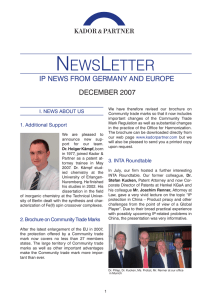
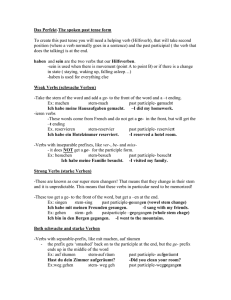
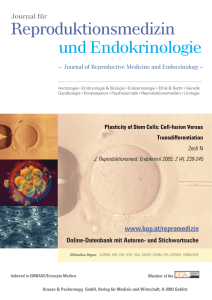
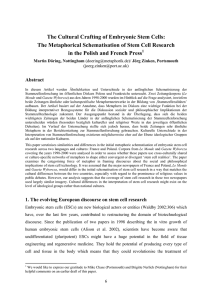
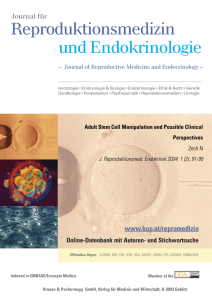
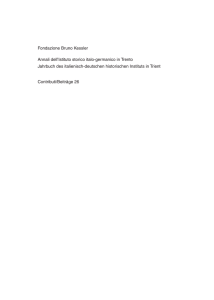

![D1A5 Starke Verben [Strong Verbs]](http://s1.studylibde.com/store/data/005537802_1-7c1b99dd5766654382e175dbf31adcce-300x300.png)
